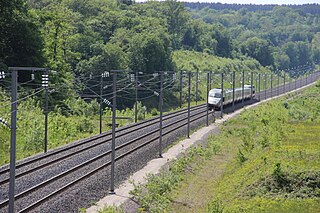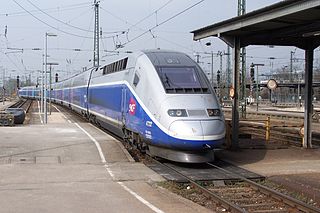
The TGV is France's intercity high-speed rail service, operated mainly by SNCF. SNCF worked on a high-speed rail network from 1966 to 1974 and presented the project to President Georges Pompidou who approved it. Originally designed as turbotrains to be powered by gas turbines, TGV prototypes evolved into electric trains with the 1973 oil crisis. In 1976 the SNCF ordered 87 high-speed trains from Alstom. Following the inaugural service between Paris and Lyon in 1981 on the LGV Sud-Est, the network, centered on Paris, has expanded to connect major cities across France and in neighbouring countries on a combination of high-speed and conventional lines. The TGV network in France carries about 110 million passengers a year.

The Gare de l'Est, officially Paris Est, is one of the seven large mainline railway station termini in Paris, France. It is located in the 10th arrondissement, not far southeast from the Gare du Nord, facing the Boulevard de Strasbourg, part of the north–south axis of Paris created by Georges-Eugène Haussmann.

The TGV Atlantique (TGV-A) is a class of high-speed trains used in France by SNCF; they were built by Alstom between 1988 and 1992, and were the second generation of TGV trains, following on from the TGV Sud-Est trainsets. The trains were named after the Ligne à Grande Vitesse Atlantique that they were originally built for.

The Ligne à Grande Vitesse Est européenne, typically shortened to LGV Est, is a French high-speed rail line that connects Vaires-sur-Marne and Vendenheim. The line halved the travel time between Paris and Strasbourg and provides fast services between Paris and the principal cities of Eastern France as well as Luxembourg and Germany. The LGV Est is a segment of the Main Line for Europe project to connect Paris with Budapest with high-speed rail service.

The LGV Sud-Est is a French high-speed rail line which connects the Paris and Lyon areas. It was France's first high-speed rail line. The inauguration of the first section between Saint-Florentin and Sathonay-Camp by President François Mitterrand on 22 September 1981 marked the beginning of the re-invigoration of French passenger rail service.

The TGV POS is a TGV train built by French manufacturer Alstom which is operated by the French national rail company, the SNCF, in France's high-speed rail lines. It was originally ordered by the SNCF for use on the LGV Est, which was put into service in 2007. POS is an abbreviation of Paris-Ostfrankreich-Süddeutschland, the route of the LGV Est.

The TGV Duplex is a French high-speed train of the TGV family, manufactured by Alstom, and operated by the French national railway company SNCF. They were the first TGV trainsets to use bi-level passenger carriages with a seating capacity of 508 passengers, increasing capacity on busy high-speed lines. While the TGV Duplex started as a small component of the TGV fleet, it has become one of the system's workhorses.

The LGV Rhône-Alpes is a 115 km (71 mi) French high-speed rail line situated in the Auvergne-Rhône-Alpes region which extends the LGV Sud-Est southwards. Opened to service in 1994, the line bypasses the built-up Lyon area towards the east; in addition it serves Lyon-Saint-Exupéry TGV station. Beyond Valence TGV station the line is continued by the LGV Méditerranée. LGVs Rhône-Alpes, Sud-Est and Méditerranée, when completed, received their official nickname, the City To Coast (C2C) Highway.

Mâcon-Loché TGV station is a railway station on the TGV Sud-Est located in the commune of Mâcon, Saône-et-Loire, France. Its address is 142, Rue de Pouilly-Loché, 71000 Mâcon, the station is a few kilometres from the neighbouring town of Loché. The next station southbound is Lyon Part-Dieu and the next northbound station is Le Creusot TGV.

Champagne-Ardenne TGV station is a railway station located in Bezannes, France that opened in 2007 along with the first phase of the LGV Est, a high-speed rail line running from Paris to Strasbourg. It is situated about five kilometres south of Reims; the station is a stop for TGV, Ouigo and TER Grand Est services.

Operation V150, where 150 refers to a target speed in metres per second, was a series of high-speed trials carried out on the LGV Est. The V150 was a specially configured TGV high-speed train notable for breaking the world railway speed record on 3 April 2007. The train was built in France and reached a speed of 574.8 kilometres per hour (357.2 mph) on an unopened section of the LGV Est between Strasbourg and Paris, in France topping the previous record of 515.3 kilometres per hour (320.2 mph) set in 1990.

Eckwersheim is a commune, in the Bas-Rhin department in Grand Est in north-eastern France. It is around 11 km (7 mi) north of Strasbourg.

France has a large network of high-speed rail lines. As of June 2021, the French high-speed rail network comprises 2,800 km (1,740 mi) of tracks, making it one of the largest in Europe and the world. As of early 2023, new lines are being constructed or planned. The first French high-speed railway, the LGV Sud-Est, linking the suburbs of Paris and Lyon, opened in 1981 and was at that time the only high-speed rail line in Europe.

Meuse TGV is a railway station that opened in June 2007 along with the LGV Est, a TGV high-speed rail line from Paris to Strasbourg. It is located in Les Trois-Domaines, about 30 km from Verdun and Bar-le-Duc, France. Designed by Jean-Marie Duthilleul, director of architecture for the SNCF, it is the first timber-built station in France since Abbeville in 1856.

Avelia Euroduplex, more commonly known as just Euroduplex or TGV 2N2 in France, is a high-speed double-decker train manufactured by Alstom. It is primarily operated by the French national railway company SNCF, and also in operation with the Moroccan national railway company ONCF. It is the 3rd generation of the TGV Duplex.

The Saverne Tunnel, also known as the Ernolsheim-lès-Saverne Tunnel, is a twin-bore 4-kilometre-long (2.5 mi), high-speed rail tunnel in western Bas-Rhin, France. It carries the LGV Est line of France's TGV high-speed rail network through the narrowest part of the Vosges mountain range, beneath Mont Saint-Michel and adjacent to the Saverne Pass. The tunnel consists of two bores, containing one rail track each, that are connected by passageways every 500 metres (1,600 ft). The LGV Est crosses the 270 m (890 ft) Haspelbaechel viaduct near the western end of the tunnel. The tunnel was excavated by a tunnel boring machine between November 2011 and February 2013. Civil engineering work on the tunnel ended in April 2014 and it opened with the rest of the second phase of the LGV Est on 3 July 2016. The total cost of the tunnel was approximately €200 million.

Saverne station is a French railway station located on the Noisy-le-Sec–Strasbourg railway. It is located within the commune of Saverne, in departement Bas-Rhin, in northeastern France.

The Ingenheim derailment occurred on 5 March 2020 when a TGV train derailed near Ingenheim, Bas-Rhin, Grand Est, France, on the LGV Est rail line due to a landslip. Twenty-one of the 348 passengers on board were injured, along with the driver.





















